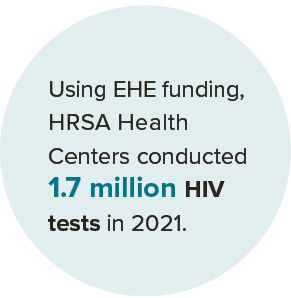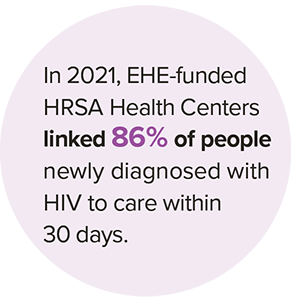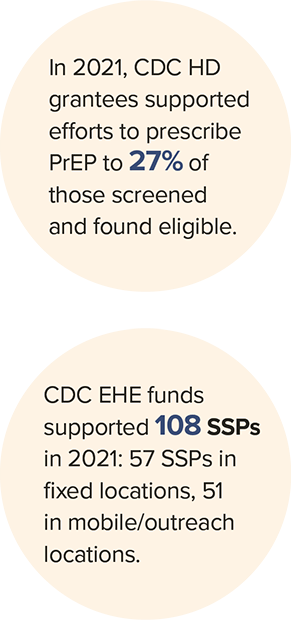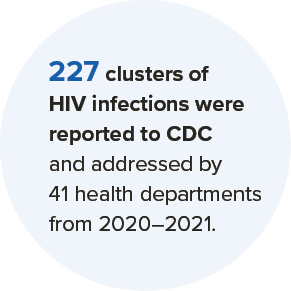Visit the COVID-19 and HIV page for the latest updates on the novel coronavirus outbreak and HIV.

EHE Accomplishments
The Ending the HIV Epidemic in the U.S. (EHE) initiative aims to reduce new HIV infections by 90% by 2030. The U.S. Department of Health and Human Services (HHS) Office of the Assistant Secretary for Health coordinates EHE across HHS agencies and offices.
EHE’s comprehensive approach focuses resources in the 57 jurisdictions where they are needed most and strives to meet people where they are with the services they need. The EHE initiative has scaled up four science-based strategies focusing on ending the epidemic: DIAGNOSE, TREAT, PREVENT, and RESPOND. For each of these strategic pillars, there have been significant strides toward ending the HIV epidemic.

Diagnose all people with HIV as early as possible
The pathway to HIV prevention and treatment begins with an HIV test.
CDC recipients used EHE funding to conduct almost 250,000 HIV tests, which identified more than 3,000 people with HIV in 2021.
In 2021, CDC also distributed 100,000 free HIV self-test kits to populations disproportionately affected by HIV, including African American and Hispanic/Latino communities and transgender women. CDC grantees also distributed more than 16,000 self-test kits.
At EHE-funded Health Centers, the Health Resources and Services Administration’s (HRSA) Bureau of Primary Health Care (BPHC) served nearly 9 million patients, of which 79% were racial and ethnic minorities.

Treat people with HIV rapidly and effectively to reach sustained viral suppression
Linkage to and receipt of ongoing care and treatment are critical for the health of people with HIV.
CDC grantees used EHE funding to link 84% of people newly diagnosed with HIV to medical care within 30 days. In addition, 100% of previously diagnosed people who were not receiving care were provided or referred to medication adherence support.
- Among CDC EHE-funded programs, 3 jurisdictions met the 2025 goal of linking 95% of newly diagnosed persons to HIV care.
In 2020, HRSA HIV/AIDS Bureau (HAB) EHE recipients served 19,421 new and re-engaged in care clients.
HRSA HAB EHE-funded grant recipients employed innovative program services including:
- Telehealth
- Mobile apps and text messaging
- One-stop-shop service models
- Mobile or home delivered services
- Extended hours

Prevent new HIV transmissions by using proven interventions
Agencies are supporting proven interventions, including pre-exposure prophylaxis (PrEP) and comprehensive syringe services programs (SSPs).
In 2021, CDC health department grantees identified more than 140,000 HIV-negative people through testing efforts in EHE areas, of which 64% were screened for PrEP. Of those eligible for PrEP, 27% were prescribed PrEP.
- Among CDC EHE-funded programs, 5 jurisdictions met the 2025 goal by linking or prescribing PrEP for at least 50% of eligible people.
CDC investments in sexually transmitted infection (STI) clinics in 2021 also identified more than 15,000 patients as PrEP eligible, and of these, 40% of the patients were newly prescribed or continued on PrEP.
Using EHE funding, HRSA BPHC Health Centers provided PrEP management services to more than 52,000 patients in 2021.

Respond quickly to potential HIV outbreaks to get vital prevention and treatment services to people who need them
Rapidly available data allow health departments and partners to quickly direct resources to communities that need them most by identifying and addressing gaps in services.
Among people who were tested as part of cluster response, the positivity rate was almost 10% (compared with 0.5% for other testing programs).
More than 500 (40%) people who were not virally suppressed at the time that they were found to be part of a cluster reached viral suppression within 6 months.
HIV WORKFORCE
CDC and HRSA are using EHE funds to further build a culturally competent HIV prevention and care workforce. Technical assistance and trainings aim to help health departments, healthcare organizations, clinicians, and community-based organizations improve the quality of HIV prevention and care.
New tool for providers – the HIV Care Tools app
COMMUNITY ENGAGEMENT
Meaningful, ongoing community engagement at every level has been fundamental to EHE since the beginning. HRSA HAB hosted 16 virtual community listening sessions, reaching more than 1,900 attendees in 2021. In addition, CDC’s ongoing events reached 1,200 participants in 2022. Federal agencies will continue to collaborate to enhance these opportunities and hear from members of the HIV community.
These accomplishments, which occurred in the midst of the tremendous challenges experienced by the medical, social services, and public health systems over the last few years, show the potential the EHE initiative has to end the HIV epidemic in the United States. Accelerated investments in EHE are vital to regain momentum, advance innovation, and achieve health equity.